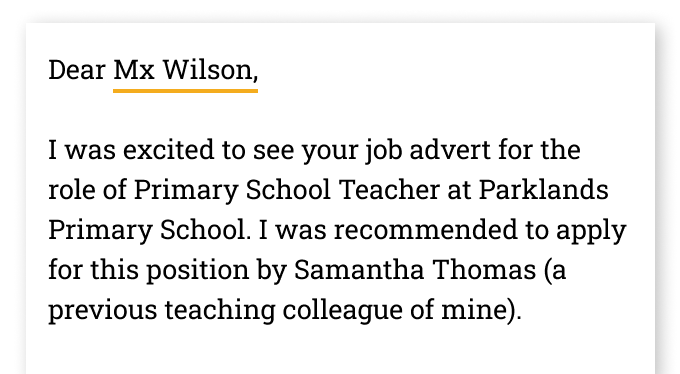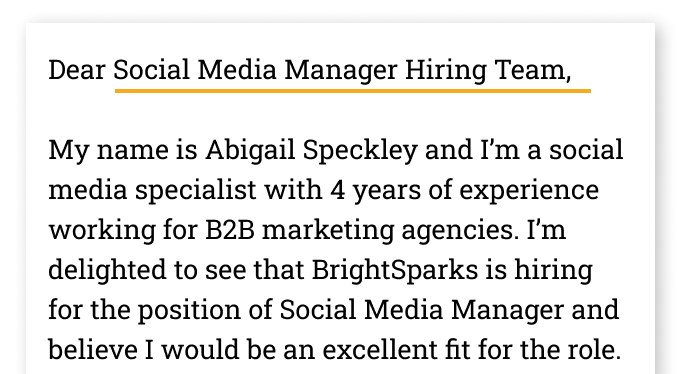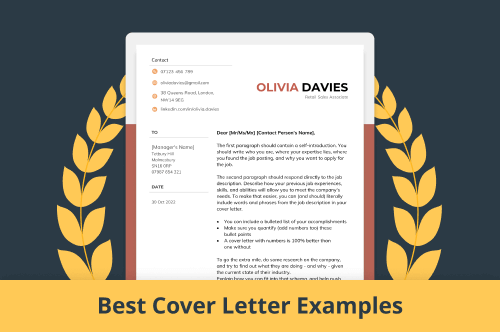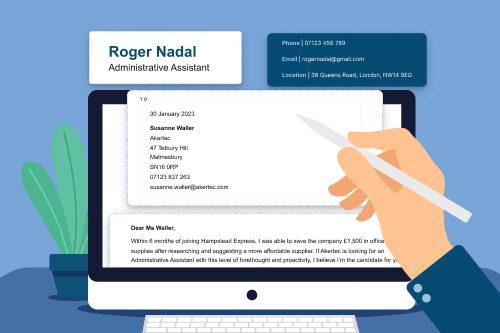‘Dear Sir or Madam’ is a formal way to address a recipient whose name, gender, or title you don’t know. Although ‘Dear Sir or Madam’ is formal and courteous, you should avoid using it to start a cover letter, business letter, or email.
Below, we explain why you shouldn’t use ‘Dear Sir or Madam’ and offer some alternative greetings that will help you communicate more effectively.
Should I use ‘Dear Sir or Madam’ in a cover letter or email?
No, you shouldn’t use ‘Dear Sir or Madam’ in an email or a cover letter.
The greeting ‘Dear Sir or Madam’ is inappropriate to use when writing an email or a cover letter for the following reasons:
1. ‘Dear Sir or Madam’ shows a lack of effort
Traditionally, you’d use ‘Dear Sir or Madam’ to address a contact person whose name, gender, and title you didn’t know.
But Google and social media have made it much easier to find out who the contact person is before you write. The greeting ‘Dear Sir or Madam’ makes it sound like you haven’t bothered to do your research.
And if you’re writing a cover letter for a job, using ‘Dear Sir or Madam’ may suggest to employers that you’re sending out the same application to multiple positions.
2. ‘Dear Sir or Madam’ is outdated and overly formal
Greetings like ‘Dear Sir/Madam’ or ‘To Whom It May Concern’ are rarely used in business letters today, so using this salutation makes your writing appear awkward and may cause employers to think you’re not up-to-date with modern job search practices.
3. ‘Dear Sir or Madam’ isn’t gender-inclusive
Not all contact people identify with the gendered terms ‘Sir’ or ‘Madam’. Assuming someone’s gender might cause offence and make a bad first impression.
Using a gendered greeting on your cover letter might even hurt your chances of getting the job.
Instead, try starting a cover letter or email with the gender-neutral salutation [Mx] followed by their given name or surname.
Dear Sir or Madam Alternatives for a Cover Letter
If you’re wondering how to address a cover letter or email in a way that encourages employers to continue reading your application, look no further.
Here are some alternative greetings to help you learn how to write a cover letter smoothly and appropriately address a company’s contact person:
- Dear [Mr/Ms/Mx] [Contact Person’s Surname],
- Dear [Job Title],
- Dear [Department Name],
- Dear Recruiter,
- Dear Hiring Manager,
- Dear Recruiting Team,
- Dear Recruitment Manager,
- Dear Human Resources Director,
- Dear [Position You Want] Hiring Team,
- Dear Head of [Team],
- Dear [Committee Name],
- Dear Sir/Dame [First Name],
Remember that generic greetings like Dear Recruiter, Dear Hiring Manager, or Dear Recruiting Team may still come across as impersonal, though they are less awkward than ‘Dear Sir/Madam’.
Dear Sir/Madam Alternatives for a Business Letter or Email
If you’re looking for a professional greeting to start a business letter or email, you can address the contact person in one of these ways:
- Dear [Given Name],
- Dear Mr/Ms/Mx [Surname],
- Dear [Job Title],
- Dear [Department],
Always use ‘Dear’ if you are writing a cover letter or email cover letter — even if you are writing a cover letter for an internal position.
Whether you should address a named contact by their given name or surname will depend on your relationship to them and the level of formality required.
‘Hello’ is slightly more casual, but it’s acceptable as a greeting for other professional purposes if you want to start a letter without ‘Dear’:
- Hello [Contact Person’s Name]
- Hello [Company Name]
- Hello [Department Name]
- Hello [Job Title]
Using professional or academic titles instead of ‘Dear Sir/Madam’
If the person you’re addressing in your cover letter or email holds a professional or academic title such as ‘Prof.’ (short for ‘Professor’) or Dr (short for ‘Doctor), use Google or LinkedIn to search for their contact details and ensure they’re currently still using the same title.
This is how to address an employer with an academic or professional title:
Dear Prof. Levitt,
Dear Dr Mischenko,
4 good example cover letters and emails that start without Dear Sir/Madam’
Whether you’re applying for a job or contacting a potential business partner or customer, greeting them correctly will make a better first impression and encourage them to read your letter or email more carefully.
You also need a well-written CV to make a good first impression. The fastest and easiest way to get your CV ready to email your target employer is to use an AI-driven CV creator.
Below are four examples of email and cover letter introductions that use alternative greetings instead of ‘Dear Sir/Madam’.
1. First, have a look at this email cover letter example for a UX researcher role:
2. Here’s another example of a cover letter greeting that directly addresses the contact person using the gender-neutral title [Mx] along with their surname:
3. This cover letter example starts by politely greeting the entire recruitment team:
4. In this example, the applicant addresses the hiring team by the position they are hiring for:
How to professionally end a cover letter or email
Now that you understand how to start your cover letter appropriately, remember to also use traditional cover letter etiquette when closing your cover letter or email.
Closing your cover letter correctly is essential because it highlights your professionalism, shows you pay attention to detail, and ends your application positively.
Here’s how to end a cover letter or email:
Ending a cover letter with 'Yours faithfully'
If your cover letter starts with any opening that doesn’t feature the person’s name (e.g., Dear Hiring Manager), then end your cover letter or email with ‘Yours faithfully’.
Ending a cover letter with 'Yours sincerely'
If your cover letter begins with a person’s name, then end your letter or email with ‘Yours sincerely’.
If all this advice has gone over your head, simplify things by using a cover letter builder. A builder will format your cover letter correctly, including using the right greeting.








